Analyzing the Revenue Generation Strategies of Texas Spine Clinic
VerifiedAdded on 2020/04/15
|12
|3444
|44
AI Summary
The Texas Spine Clinic has effectively integrated strategic financial management with quality service provision to ensure sustainable growth and high operational efficiency. Key elements include dynamic pricing strategies, diverse revenue streams through partnerships with major hospitals, and significant investment in healthcare technology. These efforts are underpinned by robust human resource management practices that focus on employee well-being and ethical treatment. By leveraging these approaches, the clinic has achieved a steady cash flow and improved patient care standards, setting an exemplary model for financial and operational excellence in healthcare.
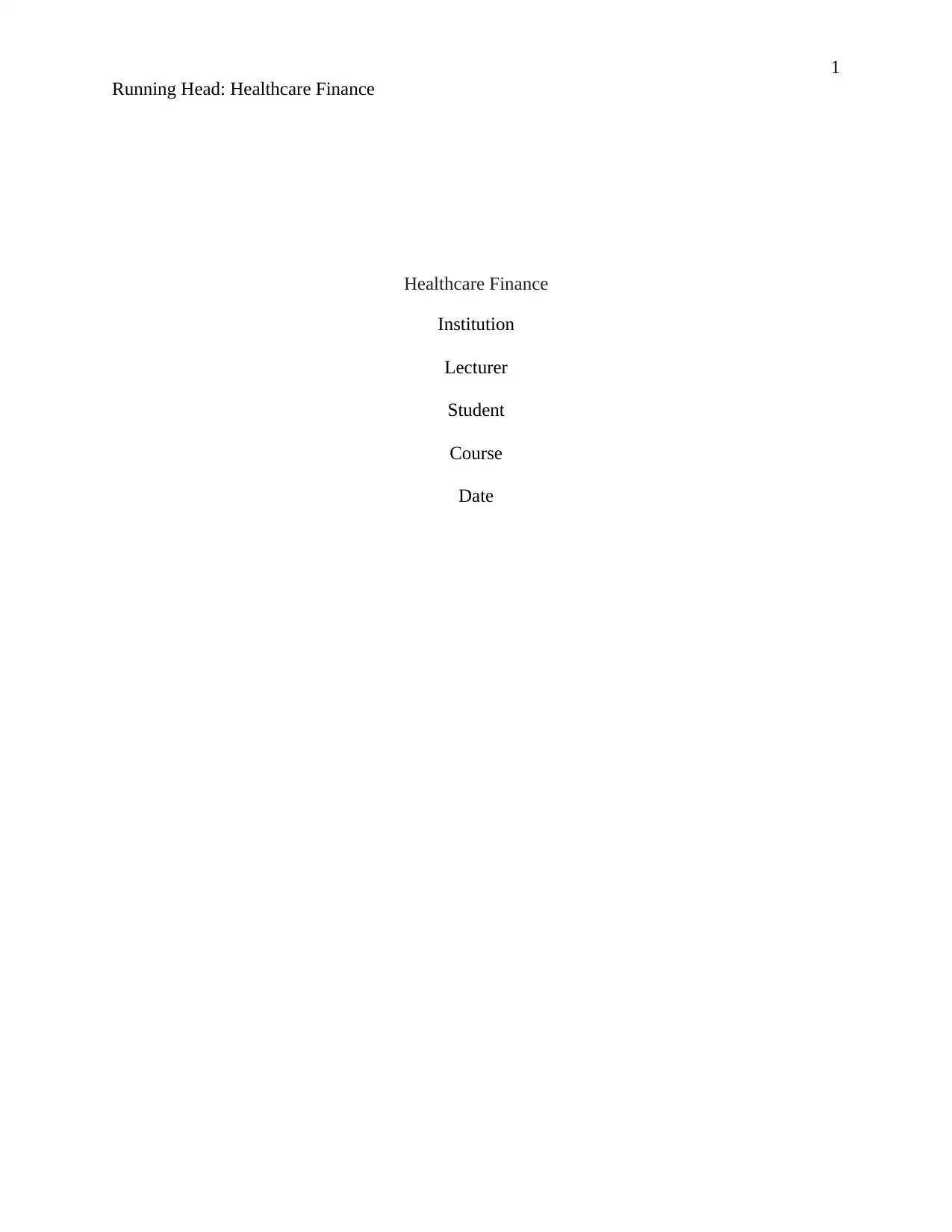
1
Running Head: Healthcare Finance
Healthcare Finance
Institution
Lecturer
Student
Course
Date
Running Head: Healthcare Finance
Healthcare Finance
Institution
Lecturer
Student
Course
Date
Paraphrase This Document
Need a fresh take? Get an instant paraphrase of this document with our AI Paraphraser
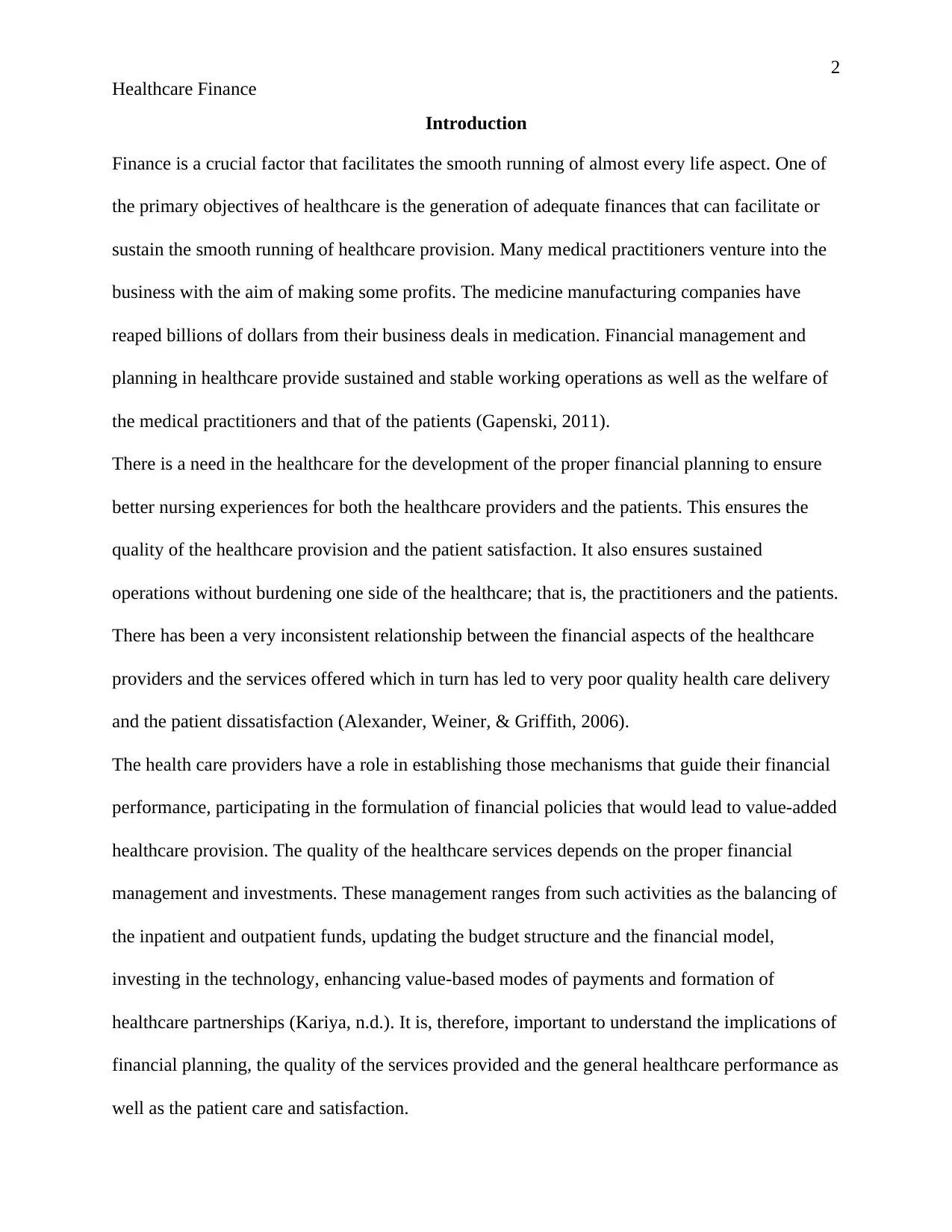
2
Healthcare Finance
Introduction
Finance is a crucial factor that facilitates the smooth running of almost every life aspect. One of
the primary objectives of healthcare is the generation of adequate finances that can facilitate or
sustain the smooth running of healthcare provision. Many medical practitioners venture into the
business with the aim of making some profits. The medicine manufacturing companies have
reaped billions of dollars from their business deals in medication. Financial management and
planning in healthcare provide sustained and stable working operations as well as the welfare of
the medical practitioners and that of the patients (Gapenski, 2011).
There is a need in the healthcare for the development of the proper financial planning to ensure
better nursing experiences for both the healthcare providers and the patients. This ensures the
quality of the healthcare provision and the patient satisfaction. It also ensures sustained
operations without burdening one side of the healthcare; that is, the practitioners and the patients.
There has been a very inconsistent relationship between the financial aspects of the healthcare
providers and the services offered which in turn has led to very poor quality health care delivery
and the patient dissatisfaction (Alexander, Weiner, & Griffith, 2006).
The health care providers have a role in establishing those mechanisms that guide their financial
performance, participating in the formulation of financial policies that would lead to value-added
healthcare provision. The quality of the healthcare services depends on the proper financial
management and investments. These management ranges from such activities as the balancing of
the inpatient and outpatient funds, updating the budget structure and the financial model,
investing in the technology, enhancing value-based modes of payments and formation of
healthcare partnerships (Kariya, n.d.). It is, therefore, important to understand the implications of
financial planning, the quality of the services provided and the general healthcare performance as
well as the patient care and satisfaction.
Healthcare Finance
Introduction
Finance is a crucial factor that facilitates the smooth running of almost every life aspect. One of
the primary objectives of healthcare is the generation of adequate finances that can facilitate or
sustain the smooth running of healthcare provision. Many medical practitioners venture into the
business with the aim of making some profits. The medicine manufacturing companies have
reaped billions of dollars from their business deals in medication. Financial management and
planning in healthcare provide sustained and stable working operations as well as the welfare of
the medical practitioners and that of the patients (Gapenski, 2011).
There is a need in the healthcare for the development of the proper financial planning to ensure
better nursing experiences for both the healthcare providers and the patients. This ensures the
quality of the healthcare provision and the patient satisfaction. It also ensures sustained
operations without burdening one side of the healthcare; that is, the practitioners and the patients.
There has been a very inconsistent relationship between the financial aspects of the healthcare
providers and the services offered which in turn has led to very poor quality health care delivery
and the patient dissatisfaction (Alexander, Weiner, & Griffith, 2006).
The health care providers have a role in establishing those mechanisms that guide their financial
performance, participating in the formulation of financial policies that would lead to value-added
healthcare provision. The quality of the healthcare services depends on the proper financial
management and investments. These management ranges from such activities as the balancing of
the inpatient and outpatient funds, updating the budget structure and the financial model,
investing in the technology, enhancing value-based modes of payments and formation of
healthcare partnerships (Kariya, n.d.). It is, therefore, important to understand the implications of
financial planning, the quality of the services provided and the general healthcare performance as
well as the patient care and satisfaction.
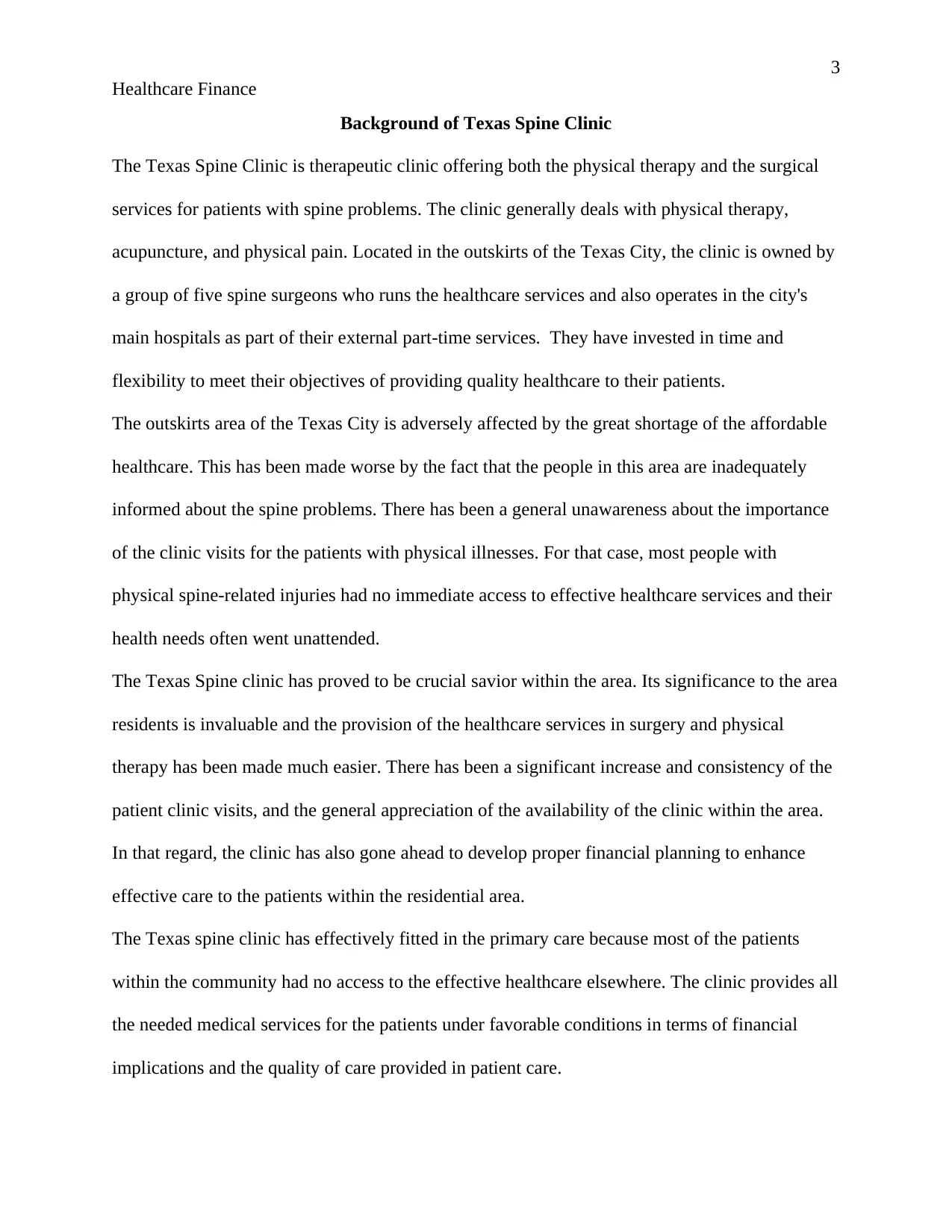
3
Healthcare Finance
Background of Texas Spine Clinic
The Texas Spine Clinic is therapeutic clinic offering both the physical therapy and the surgical
services for patients with spine problems. The clinic generally deals with physical therapy,
acupuncture, and physical pain. Located in the outskirts of the Texas City, the clinic is owned by
a group of five spine surgeons who runs the healthcare services and also operates in the city's
main hospitals as part of their external part-time services. They have invested in time and
flexibility to meet their objectives of providing quality healthcare to their patients.
The outskirts area of the Texas City is adversely affected by the great shortage of the affordable
healthcare. This has been made worse by the fact that the people in this area are inadequately
informed about the spine problems. There has been a general unawareness about the importance
of the clinic visits for the patients with physical illnesses. For that case, most people with
physical spine-related injuries had no immediate access to effective healthcare services and their
health needs often went unattended.
The Texas Spine clinic has proved to be crucial savior within the area. Its significance to the area
residents is invaluable and the provision of the healthcare services in surgery and physical
therapy has been made much easier. There has been a significant increase and consistency of the
patient clinic visits, and the general appreciation of the availability of the clinic within the area.
In that regard, the clinic has also gone ahead to develop proper financial planning to enhance
effective care to the patients within the residential area.
The Texas spine clinic has effectively fitted in the primary care because most of the patients
within the community had no access to the effective healthcare elsewhere. The clinic provides all
the needed medical services for the patients under favorable conditions in terms of financial
implications and the quality of care provided in patient care.
Healthcare Finance
Background of Texas Spine Clinic
The Texas Spine Clinic is therapeutic clinic offering both the physical therapy and the surgical
services for patients with spine problems. The clinic generally deals with physical therapy,
acupuncture, and physical pain. Located in the outskirts of the Texas City, the clinic is owned by
a group of five spine surgeons who runs the healthcare services and also operates in the city's
main hospitals as part of their external part-time services. They have invested in time and
flexibility to meet their objectives of providing quality healthcare to their patients.
The outskirts area of the Texas City is adversely affected by the great shortage of the affordable
healthcare. This has been made worse by the fact that the people in this area are inadequately
informed about the spine problems. There has been a general unawareness about the importance
of the clinic visits for the patients with physical illnesses. For that case, most people with
physical spine-related injuries had no immediate access to effective healthcare services and their
health needs often went unattended.
The Texas Spine clinic has proved to be crucial savior within the area. Its significance to the area
residents is invaluable and the provision of the healthcare services in surgery and physical
therapy has been made much easier. There has been a significant increase and consistency of the
patient clinic visits, and the general appreciation of the availability of the clinic within the area.
In that regard, the clinic has also gone ahead to develop proper financial planning to enhance
effective care to the patients within the residential area.
The Texas spine clinic has effectively fitted in the primary care because most of the patients
within the community had no access to the effective healthcare elsewhere. The clinic provides all
the needed medical services for the patients under favorable conditions in terms of financial
implications and the quality of care provided in patient care.
⊘ This is a preview!⊘
Do you want full access?
Subscribe today to unlock all pages.

Trusted by 1+ million students worldwide
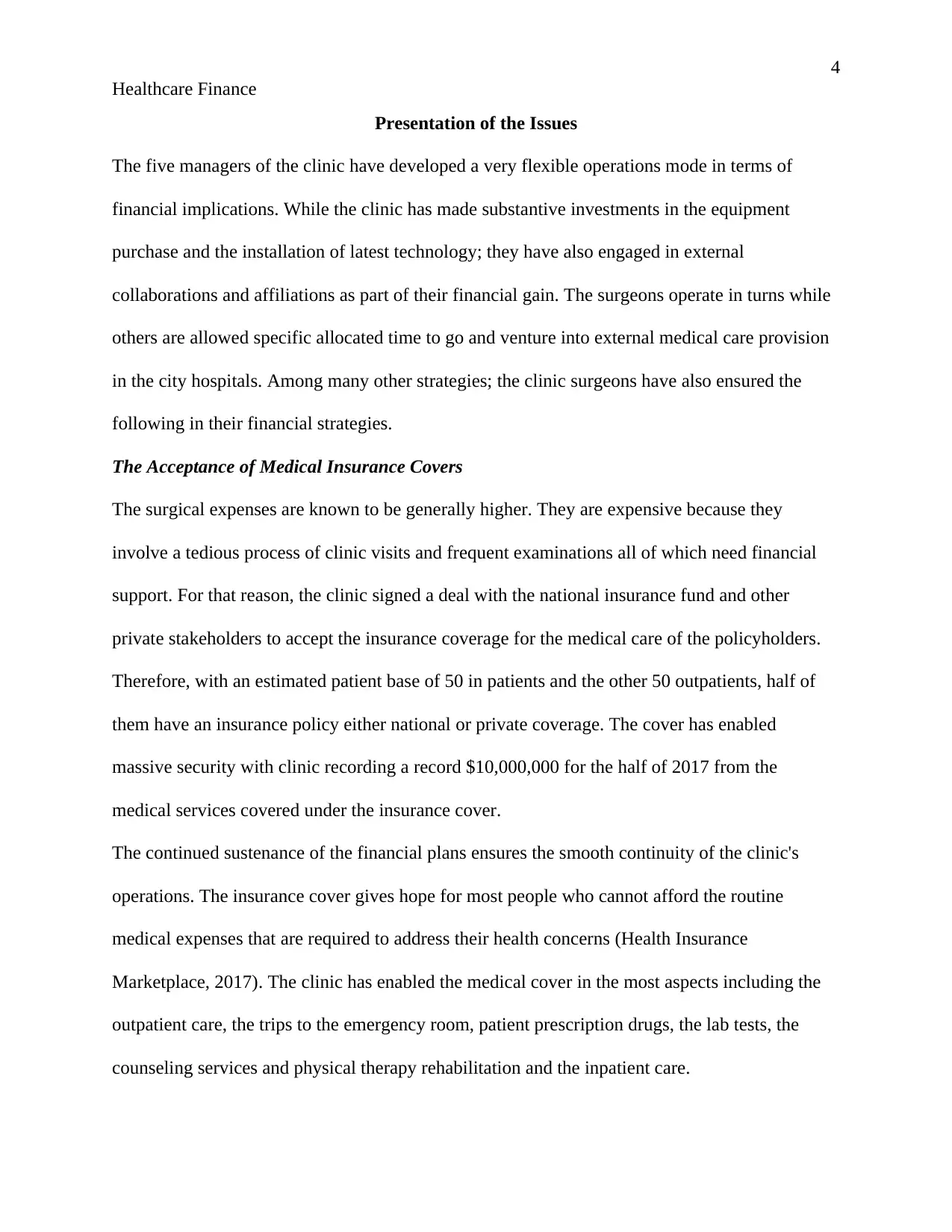
4
Healthcare Finance
Presentation of the Issues
The five managers of the clinic have developed a very flexible operations mode in terms of
financial implications. While the clinic has made substantive investments in the equipment
purchase and the installation of latest technology; they have also engaged in external
collaborations and affiliations as part of their financial gain. The surgeons operate in turns while
others are allowed specific allocated time to go and venture into external medical care provision
in the city hospitals. Among many other strategies; the clinic surgeons have also ensured the
following in their financial strategies.
The Acceptance of Medical Insurance Covers
The surgical expenses are known to be generally higher. They are expensive because they
involve a tedious process of clinic visits and frequent examinations all of which need financial
support. For that reason, the clinic signed a deal with the national insurance fund and other
private stakeholders to accept the insurance coverage for the medical care of the policyholders.
Therefore, with an estimated patient base of 50 in patients and the other 50 outpatients, half of
them have an insurance policy either national or private coverage. The cover has enabled
massive security with clinic recording a record $10,000,000 for the half of 2017 from the
medical services covered under the insurance cover.
The continued sustenance of the financial plans ensures the smooth continuity of the clinic's
operations. The insurance cover gives hope for most people who cannot afford the routine
medical expenses that are required to address their health concerns (Health Insurance
Marketplace, 2017). The clinic has enabled the medical cover in the most aspects including the
outpatient care, the trips to the emergency room, patient prescription drugs, the lab tests, the
counseling services and physical therapy rehabilitation and the inpatient care.
Healthcare Finance
Presentation of the Issues
The five managers of the clinic have developed a very flexible operations mode in terms of
financial implications. While the clinic has made substantive investments in the equipment
purchase and the installation of latest technology; they have also engaged in external
collaborations and affiliations as part of their financial gain. The surgeons operate in turns while
others are allowed specific allocated time to go and venture into external medical care provision
in the city hospitals. Among many other strategies; the clinic surgeons have also ensured the
following in their financial strategies.
The Acceptance of Medical Insurance Covers
The surgical expenses are known to be generally higher. They are expensive because they
involve a tedious process of clinic visits and frequent examinations all of which need financial
support. For that reason, the clinic signed a deal with the national insurance fund and other
private stakeholders to accept the insurance coverage for the medical care of the policyholders.
Therefore, with an estimated patient base of 50 in patients and the other 50 outpatients, half of
them have an insurance policy either national or private coverage. The cover has enabled
massive security with clinic recording a record $10,000,000 for the half of 2017 from the
medical services covered under the insurance cover.
The continued sustenance of the financial plans ensures the smooth continuity of the clinic's
operations. The insurance cover gives hope for most people who cannot afford the routine
medical expenses that are required to address their health concerns (Health Insurance
Marketplace, 2017). The clinic has enabled the medical cover in the most aspects including the
outpatient care, the trips to the emergency room, patient prescription drugs, the lab tests, the
counseling services and physical therapy rehabilitation and the inpatient care.
Paraphrase This Document
Need a fresh take? Get an instant paraphrase of this document with our AI Paraphraser
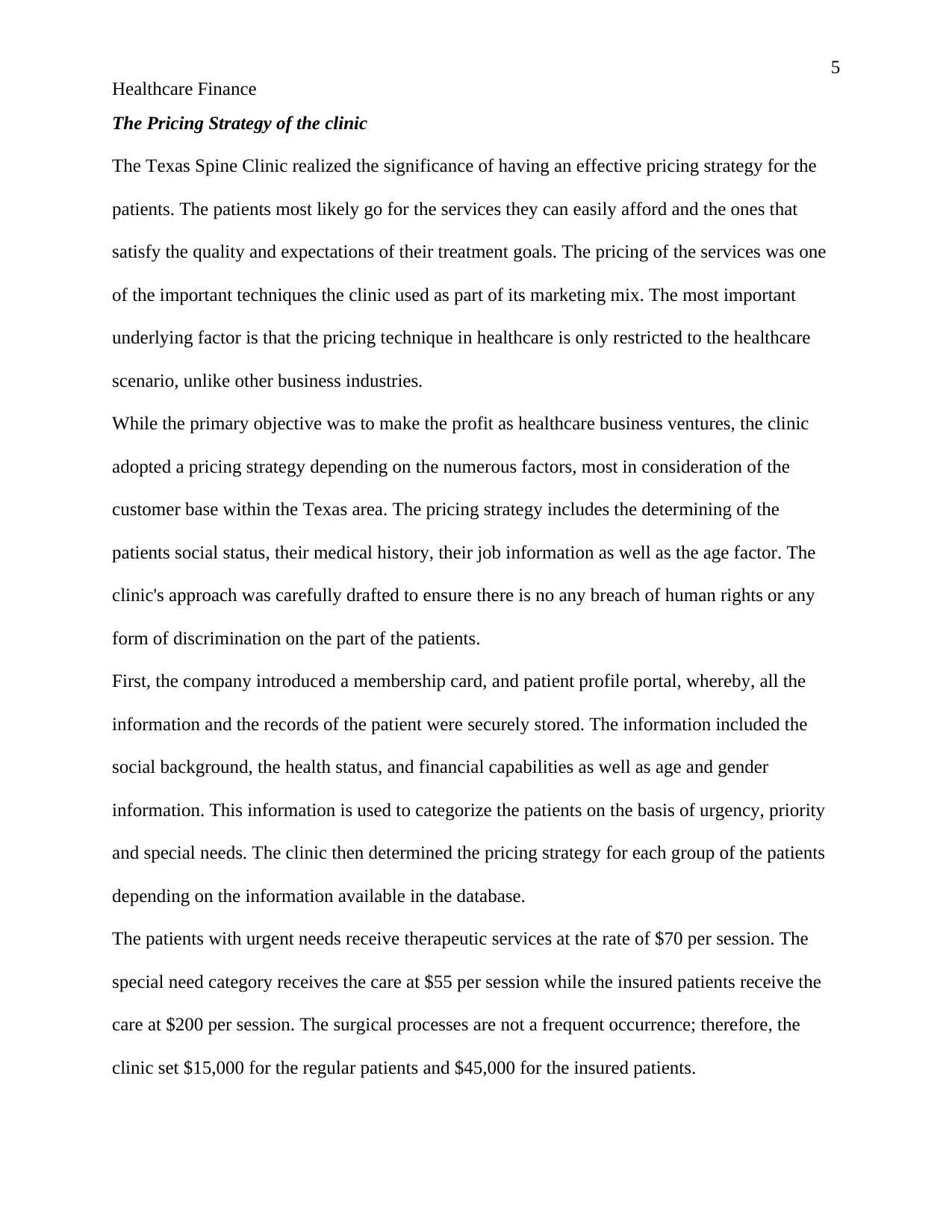
5
Healthcare Finance
The Pricing Strategy of the clinic
The Texas Spine Clinic realized the significance of having an effective pricing strategy for the
patients. The patients most likely go for the services they can easily afford and the ones that
satisfy the quality and expectations of their treatment goals. The pricing of the services was one
of the important techniques the clinic used as part of its marketing mix. The most important
underlying factor is that the pricing technique in healthcare is only restricted to the healthcare
scenario, unlike other business industries.
While the primary objective was to make the profit as healthcare business ventures, the clinic
adopted a pricing strategy depending on the numerous factors, most in consideration of the
customer base within the Texas area. The pricing strategy includes the determining of the
patients social status, their medical history, their job information as well as the age factor. The
clinic's approach was carefully drafted to ensure there is no any breach of human rights or any
form of discrimination on the part of the patients.
First, the company introduced a membership card, and patient profile portal, whereby, all the
information and the records of the patient were securely stored. The information included the
social background, the health status, and financial capabilities as well as age and gender
information. This information is used to categorize the patients on the basis of urgency, priority
and special needs. The clinic then determined the pricing strategy for each group of the patients
depending on the information available in the database.
The patients with urgent needs receive therapeutic services at the rate of $70 per session. The
special need category receives the care at $55 per session while the insured patients receive the
care at $200 per session. The surgical processes are not a frequent occurrence; therefore, the
clinic set $15,000 for the regular patients and $45,000 for the insured patients.
Healthcare Finance
The Pricing Strategy of the clinic
The Texas Spine Clinic realized the significance of having an effective pricing strategy for the
patients. The patients most likely go for the services they can easily afford and the ones that
satisfy the quality and expectations of their treatment goals. The pricing of the services was one
of the important techniques the clinic used as part of its marketing mix. The most important
underlying factor is that the pricing technique in healthcare is only restricted to the healthcare
scenario, unlike other business industries.
While the primary objective was to make the profit as healthcare business ventures, the clinic
adopted a pricing strategy depending on the numerous factors, most in consideration of the
customer base within the Texas area. The pricing strategy includes the determining of the
patients social status, their medical history, their job information as well as the age factor. The
clinic's approach was carefully drafted to ensure there is no any breach of human rights or any
form of discrimination on the part of the patients.
First, the company introduced a membership card, and patient profile portal, whereby, all the
information and the records of the patient were securely stored. The information included the
social background, the health status, and financial capabilities as well as age and gender
information. This information is used to categorize the patients on the basis of urgency, priority
and special needs. The clinic then determined the pricing strategy for each group of the patients
depending on the information available in the database.
The patients with urgent needs receive therapeutic services at the rate of $70 per session. The
special need category receives the care at $55 per session while the insured patients receive the
care at $200 per session. The surgical processes are not a frequent occurrence; therefore, the
clinic set $15,000 for the regular patients and $45,000 for the insured patients.
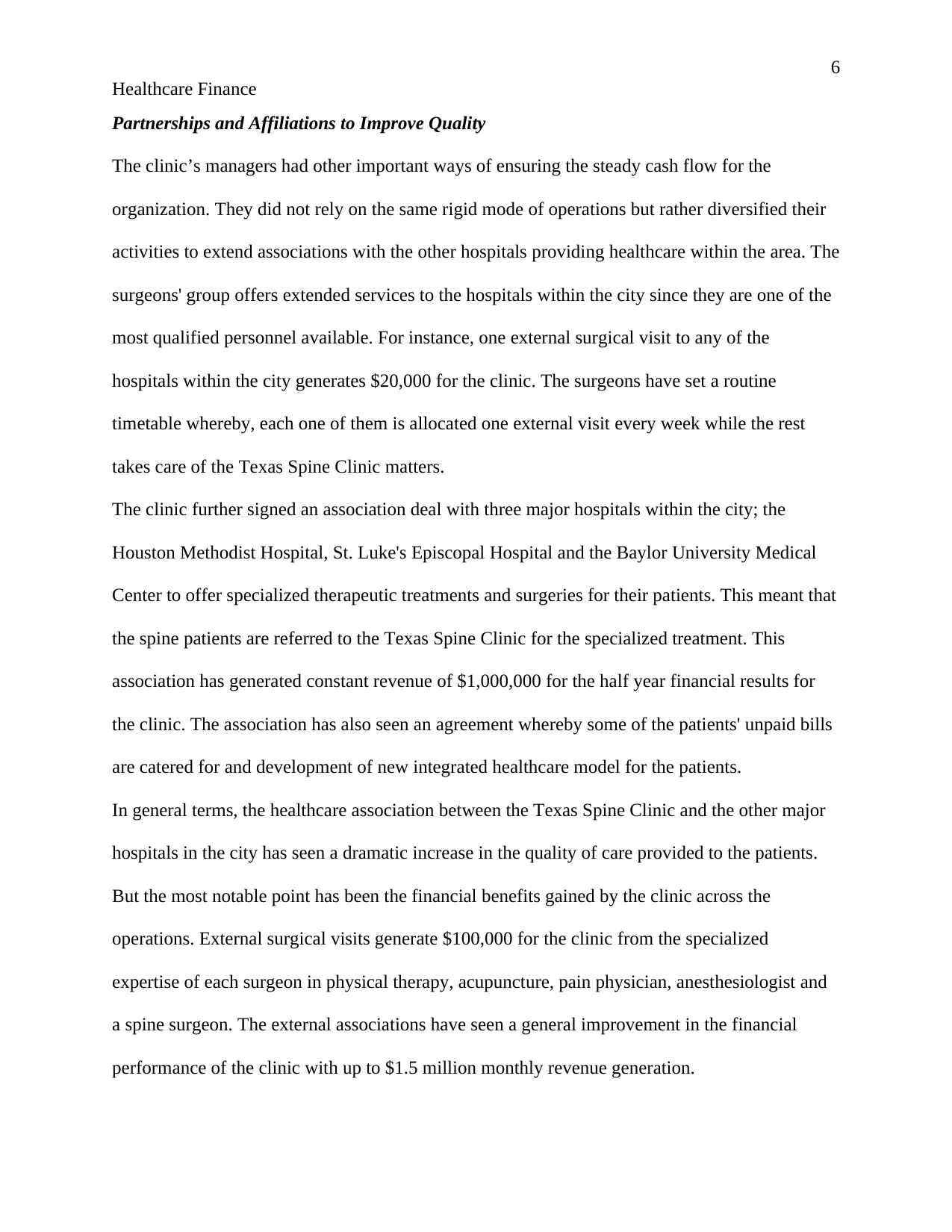
6
Healthcare Finance
Partnerships and Affiliations to Improve Quality
The clinic’s managers had other important ways of ensuring the steady cash flow for the
organization. They did not rely on the same rigid mode of operations but rather diversified their
activities to extend associations with the other hospitals providing healthcare within the area. The
surgeons' group offers extended services to the hospitals within the city since they are one of the
most qualified personnel available. For instance, one external surgical visit to any of the
hospitals within the city generates $20,000 for the clinic. The surgeons have set a routine
timetable whereby, each one of them is allocated one external visit every week while the rest
takes care of the Texas Spine Clinic matters.
The clinic further signed an association deal with three major hospitals within the city; the
Houston Methodist Hospital, St. Luke's Episcopal Hospital and the Baylor University Medical
Center to offer specialized therapeutic treatments and surgeries for their patients. This meant that
the spine patients are referred to the Texas Spine Clinic for the specialized treatment. This
association has generated constant revenue of $1,000,000 for the half year financial results for
the clinic. The association has also seen an agreement whereby some of the patients' unpaid bills
are catered for and development of new integrated healthcare model for the patients.
In general terms, the healthcare association between the Texas Spine Clinic and the other major
hospitals in the city has seen a dramatic increase in the quality of care provided to the patients.
But the most notable point has been the financial benefits gained by the clinic across the
operations. External surgical visits generate $100,000 for the clinic from the specialized
expertise of each surgeon in physical therapy, acupuncture, pain physician, anesthesiologist and
a spine surgeon. The external associations have seen a general improvement in the financial
performance of the clinic with up to $1.5 million monthly revenue generation.
Healthcare Finance
Partnerships and Affiliations to Improve Quality
The clinic’s managers had other important ways of ensuring the steady cash flow for the
organization. They did not rely on the same rigid mode of operations but rather diversified their
activities to extend associations with the other hospitals providing healthcare within the area. The
surgeons' group offers extended services to the hospitals within the city since they are one of the
most qualified personnel available. For instance, one external surgical visit to any of the
hospitals within the city generates $20,000 for the clinic. The surgeons have set a routine
timetable whereby, each one of them is allocated one external visit every week while the rest
takes care of the Texas Spine Clinic matters.
The clinic further signed an association deal with three major hospitals within the city; the
Houston Methodist Hospital, St. Luke's Episcopal Hospital and the Baylor University Medical
Center to offer specialized therapeutic treatments and surgeries for their patients. This meant that
the spine patients are referred to the Texas Spine Clinic for the specialized treatment. This
association has generated constant revenue of $1,000,000 for the half year financial results for
the clinic. The association has also seen an agreement whereby some of the patients' unpaid bills
are catered for and development of new integrated healthcare model for the patients.
In general terms, the healthcare association between the Texas Spine Clinic and the other major
hospitals in the city has seen a dramatic increase in the quality of care provided to the patients.
But the most notable point has been the financial benefits gained by the clinic across the
operations. External surgical visits generate $100,000 for the clinic from the specialized
expertise of each surgeon in physical therapy, acupuncture, pain physician, anesthesiologist and
a spine surgeon. The external associations have seen a general improvement in the financial
performance of the clinic with up to $1.5 million monthly revenue generation.
⊘ This is a preview!⊘
Do you want full access?
Subscribe today to unlock all pages.

Trusted by 1+ million students worldwide
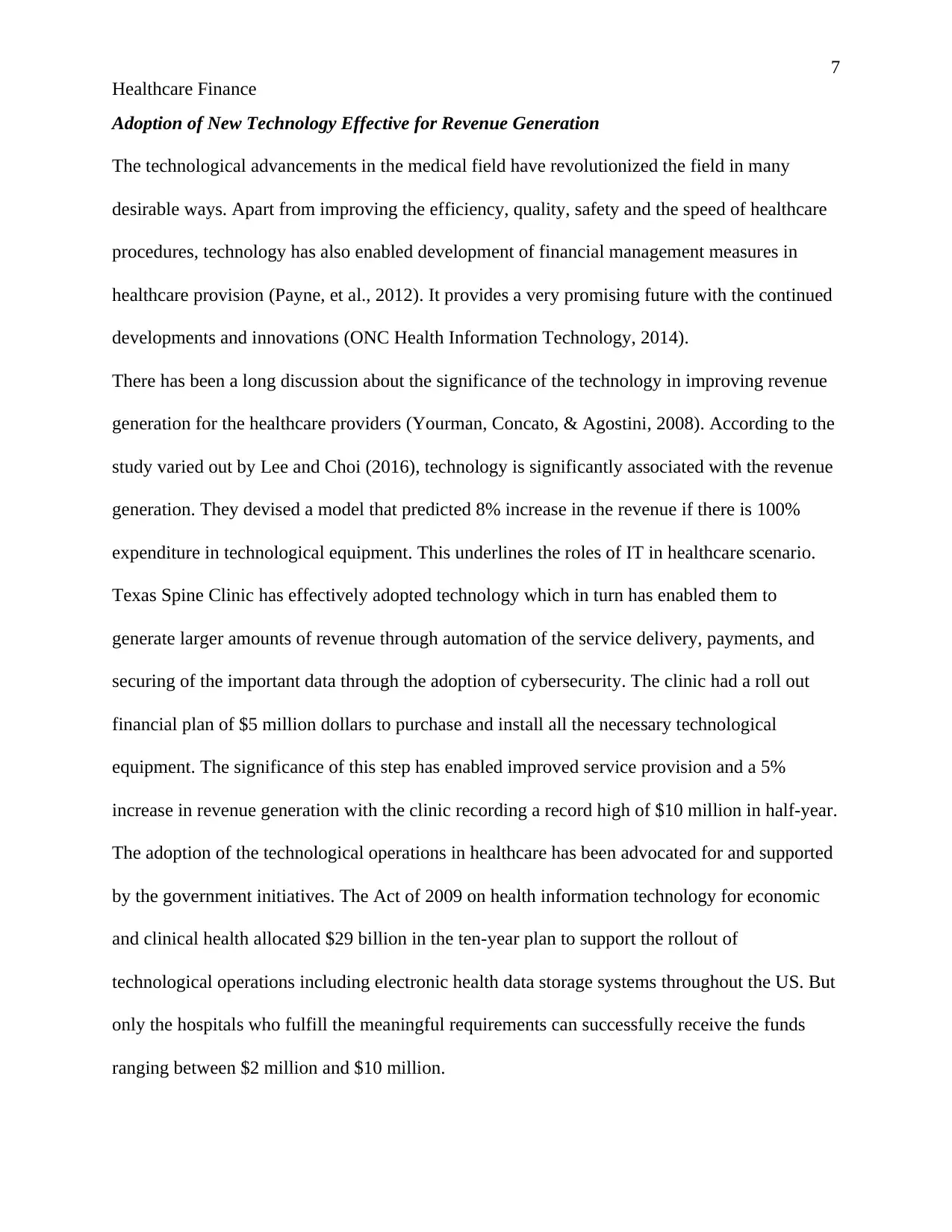
7
Healthcare Finance
Adoption of New Technology Effective for Revenue Generation
The technological advancements in the medical field have revolutionized the field in many
desirable ways. Apart from improving the efficiency, quality, safety and the speed of healthcare
procedures, technology has also enabled development of financial management measures in
healthcare provision (Payne, et al., 2012). It provides a very promising future with the continued
developments and innovations (ONC Health Information Technology, 2014).
There has been a long discussion about the significance of the technology in improving revenue
generation for the healthcare providers (Yourman, Concato, & Agostini, 2008). According to the
study varied out by Lee and Choi (2016), technology is significantly associated with the revenue
generation. They devised a model that predicted 8% increase in the revenue if there is 100%
expenditure in technological equipment. This underlines the roles of IT in healthcare scenario.
Texas Spine Clinic has effectively adopted technology which in turn has enabled them to
generate larger amounts of revenue through automation of the service delivery, payments, and
securing of the important data through the adoption of cybersecurity. The clinic had a roll out
financial plan of $5 million dollars to purchase and install all the necessary technological
equipment. The significance of this step has enabled improved service provision and a 5%
increase in revenue generation with the clinic recording a record high of $10 million in half-year.
The adoption of the technological operations in healthcare has been advocated for and supported
by the government initiatives. The Act of 2009 on health information technology for economic
and clinical health allocated $29 billion in the ten-year plan to support the rollout of
technological operations including electronic health data storage systems throughout the US. But
only the hospitals who fulfill the meaningful requirements can successfully receive the funds
ranging between $2 million and $10 million.
Healthcare Finance
Adoption of New Technology Effective for Revenue Generation
The technological advancements in the medical field have revolutionized the field in many
desirable ways. Apart from improving the efficiency, quality, safety and the speed of healthcare
procedures, technology has also enabled development of financial management measures in
healthcare provision (Payne, et al., 2012). It provides a very promising future with the continued
developments and innovations (ONC Health Information Technology, 2014).
There has been a long discussion about the significance of the technology in improving revenue
generation for the healthcare providers (Yourman, Concato, & Agostini, 2008). According to the
study varied out by Lee and Choi (2016), technology is significantly associated with the revenue
generation. They devised a model that predicted 8% increase in the revenue if there is 100%
expenditure in technological equipment. This underlines the roles of IT in healthcare scenario.
Texas Spine Clinic has effectively adopted technology which in turn has enabled them to
generate larger amounts of revenue through automation of the service delivery, payments, and
securing of the important data through the adoption of cybersecurity. The clinic had a roll out
financial plan of $5 million dollars to purchase and install all the necessary technological
equipment. The significance of this step has enabled improved service provision and a 5%
increase in revenue generation with the clinic recording a record high of $10 million in half-year.
The adoption of the technological operations in healthcare has been advocated for and supported
by the government initiatives. The Act of 2009 on health information technology for economic
and clinical health allocated $29 billion in the ten-year plan to support the rollout of
technological operations including electronic health data storage systems throughout the US. But
only the hospitals who fulfill the meaningful requirements can successfully receive the funds
ranging between $2 million and $10 million.
Paraphrase This Document
Need a fresh take? Get an instant paraphrase of this document with our AI Paraphraser
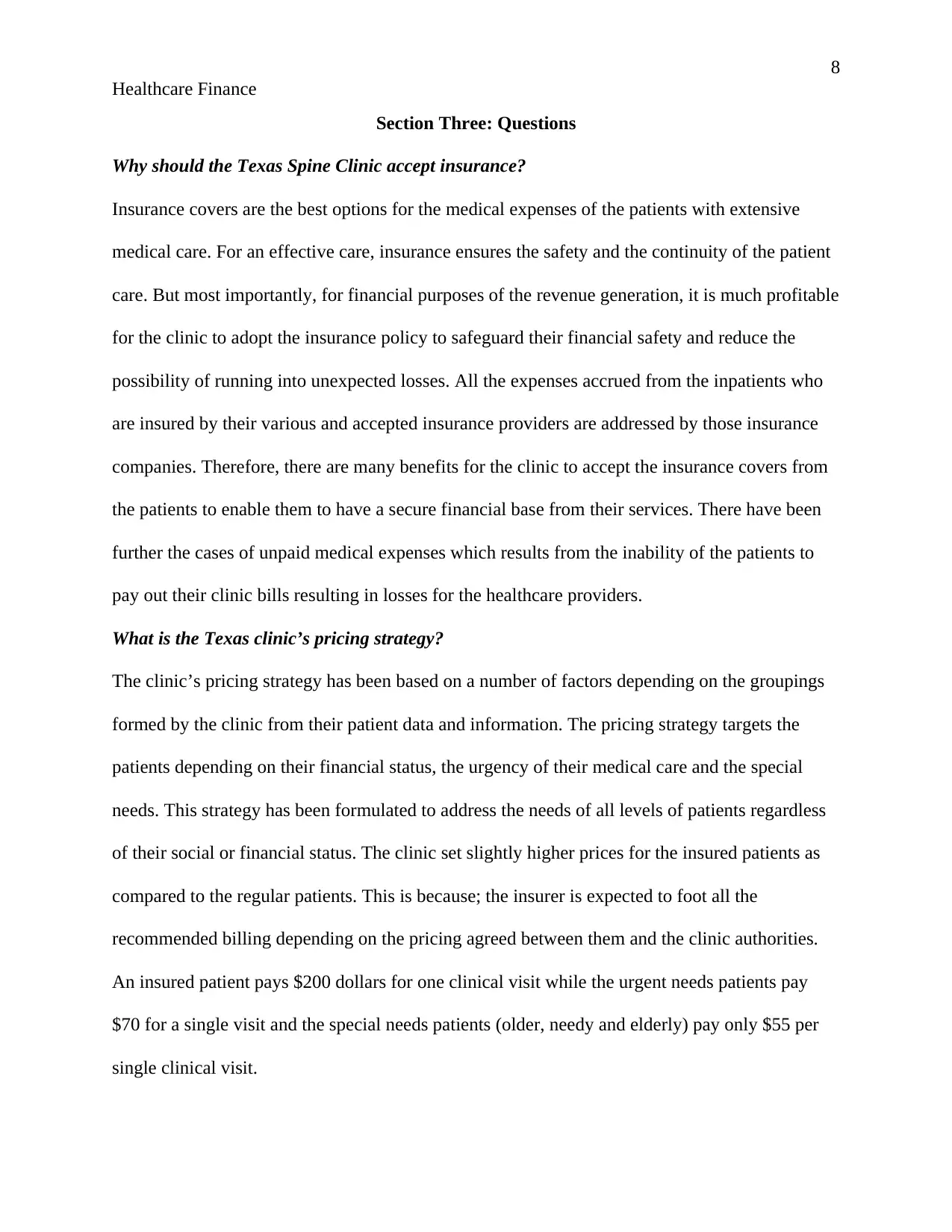
8
Healthcare Finance
Section Three: Questions
Why should the Texas Spine Clinic accept insurance?
Insurance covers are the best options for the medical expenses of the patients with extensive
medical care. For an effective care, insurance ensures the safety and the continuity of the patient
care. But most importantly, for financial purposes of the revenue generation, it is much profitable
for the clinic to adopt the insurance policy to safeguard their financial safety and reduce the
possibility of running into unexpected losses. All the expenses accrued from the inpatients who
are insured by their various and accepted insurance providers are addressed by those insurance
companies. Therefore, there are many benefits for the clinic to accept the insurance covers from
the patients to enable them to have a secure financial base from their services. There have been
further the cases of unpaid medical expenses which results from the inability of the patients to
pay out their clinic bills resulting in losses for the healthcare providers.
What is the Texas clinic’s pricing strategy?
The clinic’s pricing strategy has been based on a number of factors depending on the groupings
formed by the clinic from their patient data and information. The pricing strategy targets the
patients depending on their financial status, the urgency of their medical care and the special
needs. This strategy has been formulated to address the needs of all levels of patients regardless
of their social or financial status. The clinic set slightly higher prices for the insured patients as
compared to the regular patients. This is because; the insurer is expected to foot all the
recommended billing depending on the pricing agreed between them and the clinic authorities.
An insured patient pays $200 dollars for one clinical visit while the urgent needs patients pay
$70 for a single visit and the special needs patients (older, needy and elderly) pay only $55 per
single clinical visit.
Healthcare Finance
Section Three: Questions
Why should the Texas Spine Clinic accept insurance?
Insurance covers are the best options for the medical expenses of the patients with extensive
medical care. For an effective care, insurance ensures the safety and the continuity of the patient
care. But most importantly, for financial purposes of the revenue generation, it is much profitable
for the clinic to adopt the insurance policy to safeguard their financial safety and reduce the
possibility of running into unexpected losses. All the expenses accrued from the inpatients who
are insured by their various and accepted insurance providers are addressed by those insurance
companies. Therefore, there are many benefits for the clinic to accept the insurance covers from
the patients to enable them to have a secure financial base from their services. There have been
further the cases of unpaid medical expenses which results from the inability of the patients to
pay out their clinic bills resulting in losses for the healthcare providers.
What is the Texas clinic’s pricing strategy?
The clinic’s pricing strategy has been based on a number of factors depending on the groupings
formed by the clinic from their patient data and information. The pricing strategy targets the
patients depending on their financial status, the urgency of their medical care and the special
needs. This strategy has been formulated to address the needs of all levels of patients regardless
of their social or financial status. The clinic set slightly higher prices for the insured patients as
compared to the regular patients. This is because; the insurer is expected to foot all the
recommended billing depending on the pricing agreed between them and the clinic authorities.
An insured patient pays $200 dollars for one clinical visit while the urgent needs patients pay
$70 for a single visit and the special needs patients (older, needy and elderly) pay only $55 per
single clinical visit.
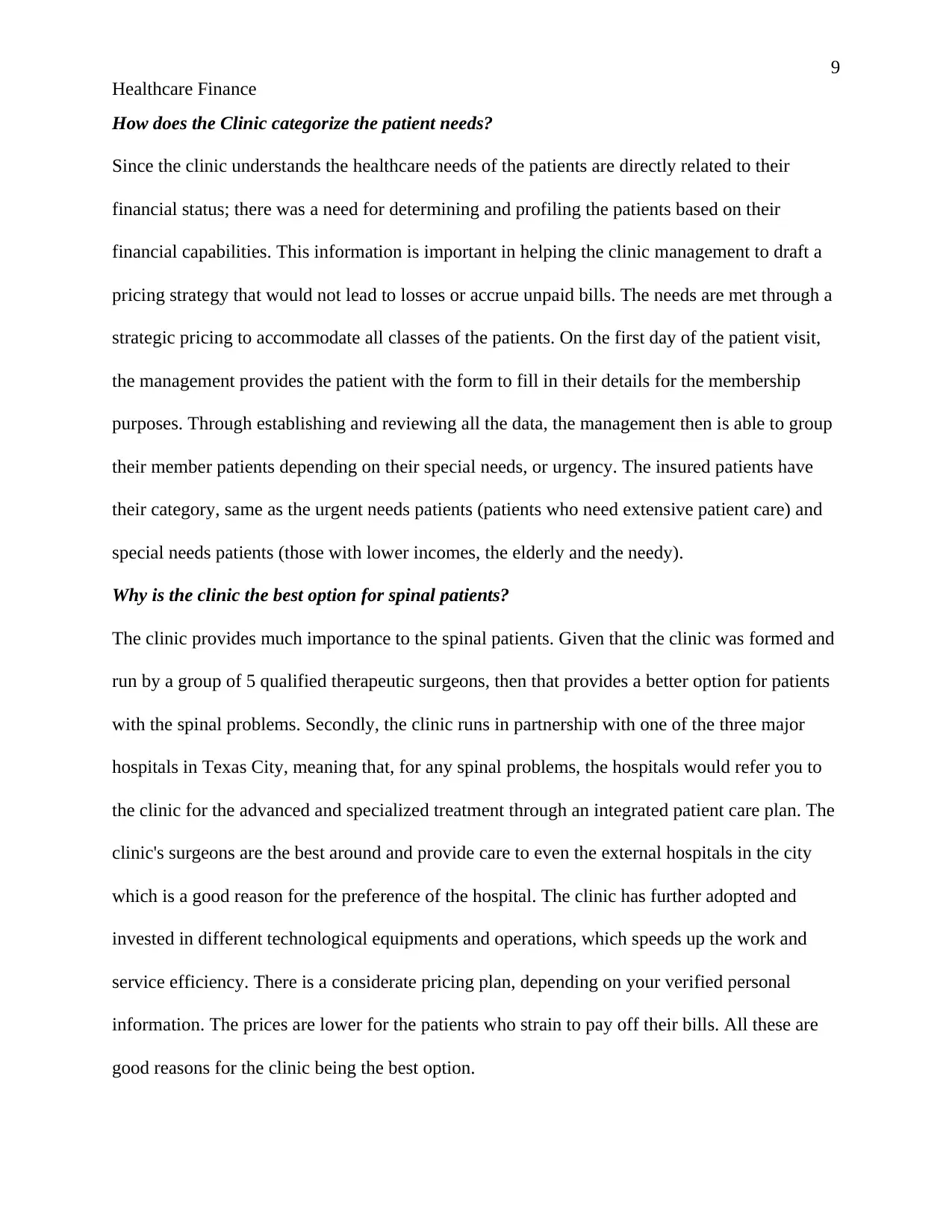
9
Healthcare Finance
How does the Clinic categorize the patient needs?
Since the clinic understands the healthcare needs of the patients are directly related to their
financial status; there was a need for determining and profiling the patients based on their
financial capabilities. This information is important in helping the clinic management to draft a
pricing strategy that would not lead to losses or accrue unpaid bills. The needs are met through a
strategic pricing to accommodate all classes of the patients. On the first day of the patient visit,
the management provides the patient with the form to fill in their details for the membership
purposes. Through establishing and reviewing all the data, the management then is able to group
their member patients depending on their special needs, or urgency. The insured patients have
their category, same as the urgent needs patients (patients who need extensive patient care) and
special needs patients (those with lower incomes, the elderly and the needy).
Why is the clinic the best option for spinal patients?
The clinic provides much importance to the spinal patients. Given that the clinic was formed and
run by a group of 5 qualified therapeutic surgeons, then that provides a better option for patients
with the spinal problems. Secondly, the clinic runs in partnership with one of the three major
hospitals in Texas City, meaning that, for any spinal problems, the hospitals would refer you to
the clinic for the advanced and specialized treatment through an integrated patient care plan. The
clinic's surgeons are the best around and provide care to even the external hospitals in the city
which is a good reason for the preference of the hospital. The clinic has further adopted and
invested in different technological equipments and operations, which speeds up the work and
service efficiency. There is a considerate pricing plan, depending on your verified personal
information. The prices are lower for the patients who strain to pay off their bills. All these are
good reasons for the clinic being the best option.
Healthcare Finance
How does the Clinic categorize the patient needs?
Since the clinic understands the healthcare needs of the patients are directly related to their
financial status; there was a need for determining and profiling the patients based on their
financial capabilities. This information is important in helping the clinic management to draft a
pricing strategy that would not lead to losses or accrue unpaid bills. The needs are met through a
strategic pricing to accommodate all classes of the patients. On the first day of the patient visit,
the management provides the patient with the form to fill in their details for the membership
purposes. Through establishing and reviewing all the data, the management then is able to group
their member patients depending on their special needs, or urgency. The insured patients have
their category, same as the urgent needs patients (patients who need extensive patient care) and
special needs patients (those with lower incomes, the elderly and the needy).
Why is the clinic the best option for spinal patients?
The clinic provides much importance to the spinal patients. Given that the clinic was formed and
run by a group of 5 qualified therapeutic surgeons, then that provides a better option for patients
with the spinal problems. Secondly, the clinic runs in partnership with one of the three major
hospitals in Texas City, meaning that, for any spinal problems, the hospitals would refer you to
the clinic for the advanced and specialized treatment through an integrated patient care plan. The
clinic's surgeons are the best around and provide care to even the external hospitals in the city
which is a good reason for the preference of the hospital. The clinic has further adopted and
invested in different technological equipments and operations, which speeds up the work and
service efficiency. There is a considerate pricing plan, depending on your verified personal
information. The prices are lower for the patients who strain to pay off their bills. All these are
good reasons for the clinic being the best option.
⊘ This is a preview!⊘
Do you want full access?
Subscribe today to unlock all pages.

Trusted by 1+ million students worldwide
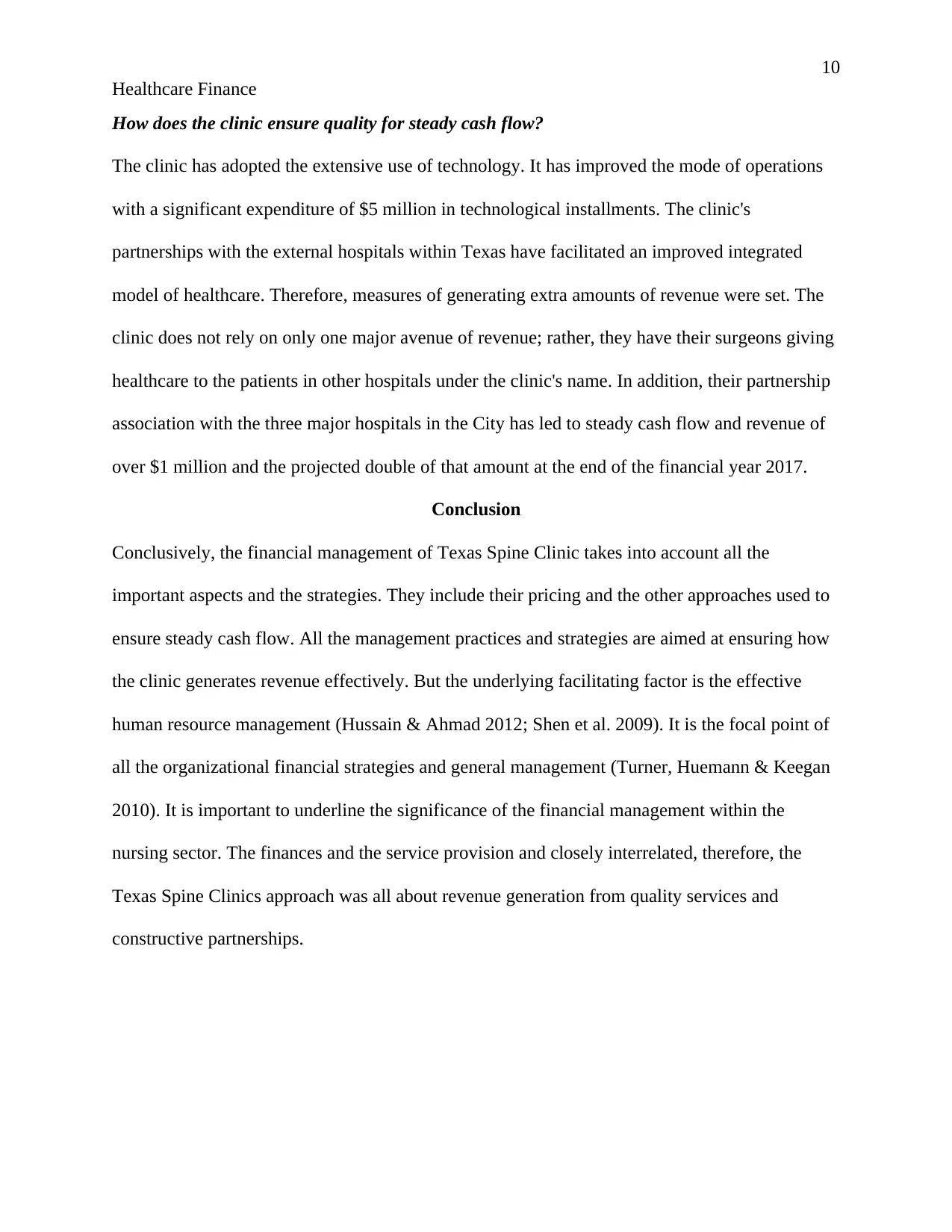
10
Healthcare Finance
How does the clinic ensure quality for steady cash flow?
The clinic has adopted the extensive use of technology. It has improved the mode of operations
with a significant expenditure of $5 million in technological installments. The clinic's
partnerships with the external hospitals within Texas have facilitated an improved integrated
model of healthcare. Therefore, measures of generating extra amounts of revenue were set. The
clinic does not rely on only one major avenue of revenue; rather, they have their surgeons giving
healthcare to the patients in other hospitals under the clinic's name. In addition, their partnership
association with the three major hospitals in the City has led to steady cash flow and revenue of
over $1 million and the projected double of that amount at the end of the financial year 2017.
Conclusion
Conclusively, the financial management of Texas Spine Clinic takes into account all the
important aspects and the strategies. They include their pricing and the other approaches used to
ensure steady cash flow. All the management practices and strategies are aimed at ensuring how
the clinic generates revenue effectively. But the underlying facilitating factor is the effective
human resource management (Hussain & Ahmad 2012; Shen et al. 2009). It is the focal point of
all the organizational financial strategies and general management (Turner, Huemann & Keegan
2010). It is important to underline the significance of the financial management within the
nursing sector. The finances and the service provision and closely interrelated, therefore, the
Texas Spine Clinics approach was all about revenue generation from quality services and
constructive partnerships.
Healthcare Finance
How does the clinic ensure quality for steady cash flow?
The clinic has adopted the extensive use of technology. It has improved the mode of operations
with a significant expenditure of $5 million in technological installments. The clinic's
partnerships with the external hospitals within Texas have facilitated an improved integrated
model of healthcare. Therefore, measures of generating extra amounts of revenue were set. The
clinic does not rely on only one major avenue of revenue; rather, they have their surgeons giving
healthcare to the patients in other hospitals under the clinic's name. In addition, their partnership
association with the three major hospitals in the City has led to steady cash flow and revenue of
over $1 million and the projected double of that amount at the end of the financial year 2017.
Conclusion
Conclusively, the financial management of Texas Spine Clinic takes into account all the
important aspects and the strategies. They include their pricing and the other approaches used to
ensure steady cash flow. All the management practices and strategies are aimed at ensuring how
the clinic generates revenue effectively. But the underlying facilitating factor is the effective
human resource management (Hussain & Ahmad 2012; Shen et al. 2009). It is the focal point of
all the organizational financial strategies and general management (Turner, Huemann & Keegan
2010). It is important to underline the significance of the financial management within the
nursing sector. The finances and the service provision and closely interrelated, therefore, the
Texas Spine Clinics approach was all about revenue generation from quality services and
constructive partnerships.
Paraphrase This Document
Need a fresh take? Get an instant paraphrase of this document with our AI Paraphraser
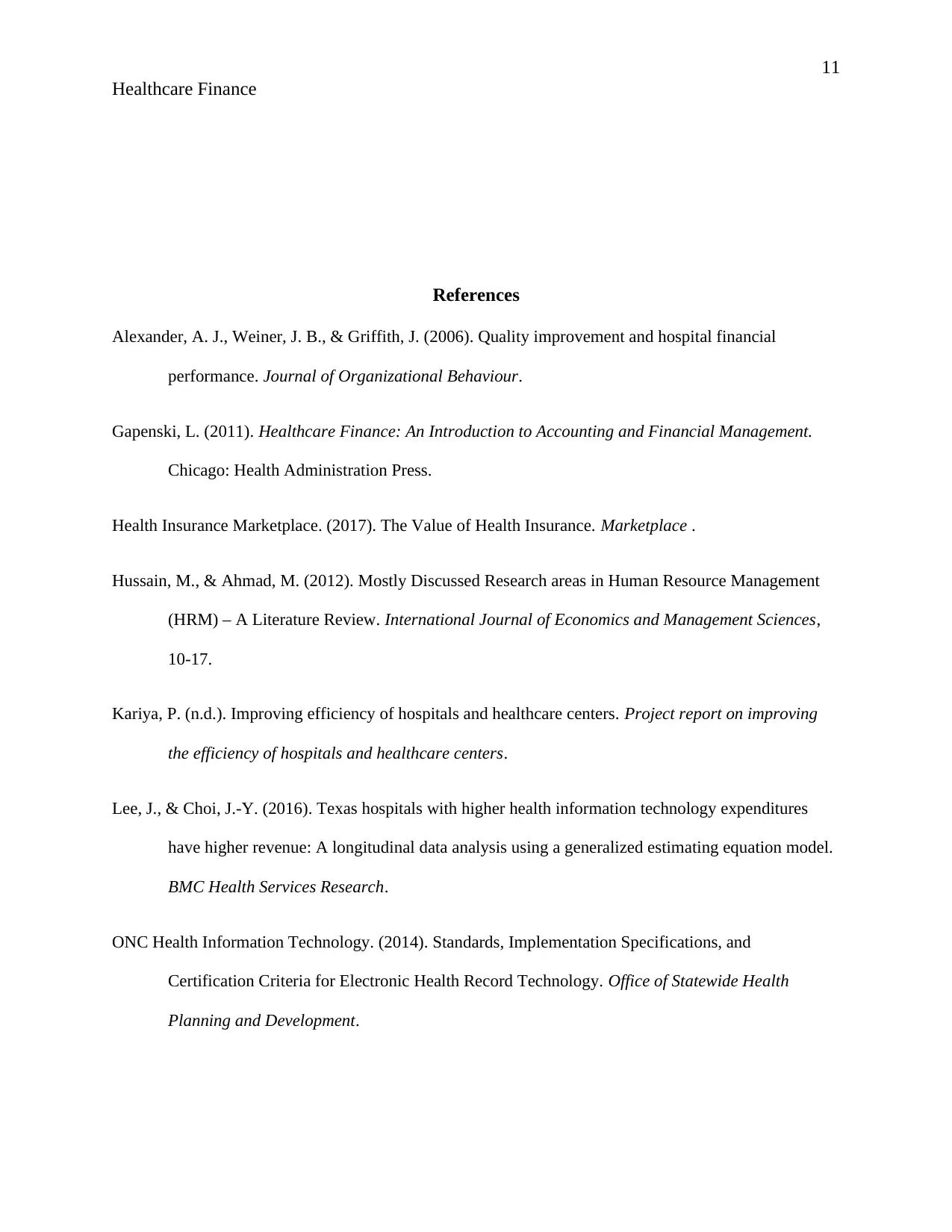
11
Healthcare Finance
References
Alexander, A. J., Weiner, J. B., & Griffith, J. (2006). Quality improvement and hospital financial
performance. Journal of Organizational Behaviour.
Gapenski, L. (2011). Healthcare Finance: An Introduction to Accounting and Financial Management.
Chicago: Health Administration Press.
Health Insurance Marketplace. (2017). The Value of Health Insurance. Marketplace .
Hussain, M., & Ahmad, M. (2012). Mostly Discussed Research areas in Human Resource Management
(HRM) – A Literature Review. International Journal of Economics and Management Sciences,
10-17.
Kariya, P. (n.d.). Improving efficiency of hospitals and healthcare centers. Project report on improving
the efficiency of hospitals and healthcare centers.
Lee, J., & Choi, J.-Y. (2016). Texas hospitals with higher health information technology expenditures
have higher revenue: A longitudinal data analysis using a generalized estimating equation model.
BMC Health Services Research.
ONC Health Information Technology. (2014). Standards, Implementation Specifications, and
Certification Criteria for Electronic Health Record Technology. Office of Statewide Health
Planning and Development.
Healthcare Finance
References
Alexander, A. J., Weiner, J. B., & Griffith, J. (2006). Quality improvement and hospital financial
performance. Journal of Organizational Behaviour.
Gapenski, L. (2011). Healthcare Finance: An Introduction to Accounting and Financial Management.
Chicago: Health Administration Press.
Health Insurance Marketplace. (2017). The Value of Health Insurance. Marketplace .
Hussain, M., & Ahmad, M. (2012). Mostly Discussed Research areas in Human Resource Management
(HRM) – A Literature Review. International Journal of Economics and Management Sciences,
10-17.
Kariya, P. (n.d.). Improving efficiency of hospitals and healthcare centers. Project report on improving
the efficiency of hospitals and healthcare centers.
Lee, J., & Choi, J.-Y. (2016). Texas hospitals with higher health information technology expenditures
have higher revenue: A longitudinal data analysis using a generalized estimating equation model.
BMC Health Services Research.
ONC Health Information Technology. (2014). Standards, Implementation Specifications, and
Certification Criteria for Electronic Health Record Technology. Office of Statewide Health
Planning and Development.
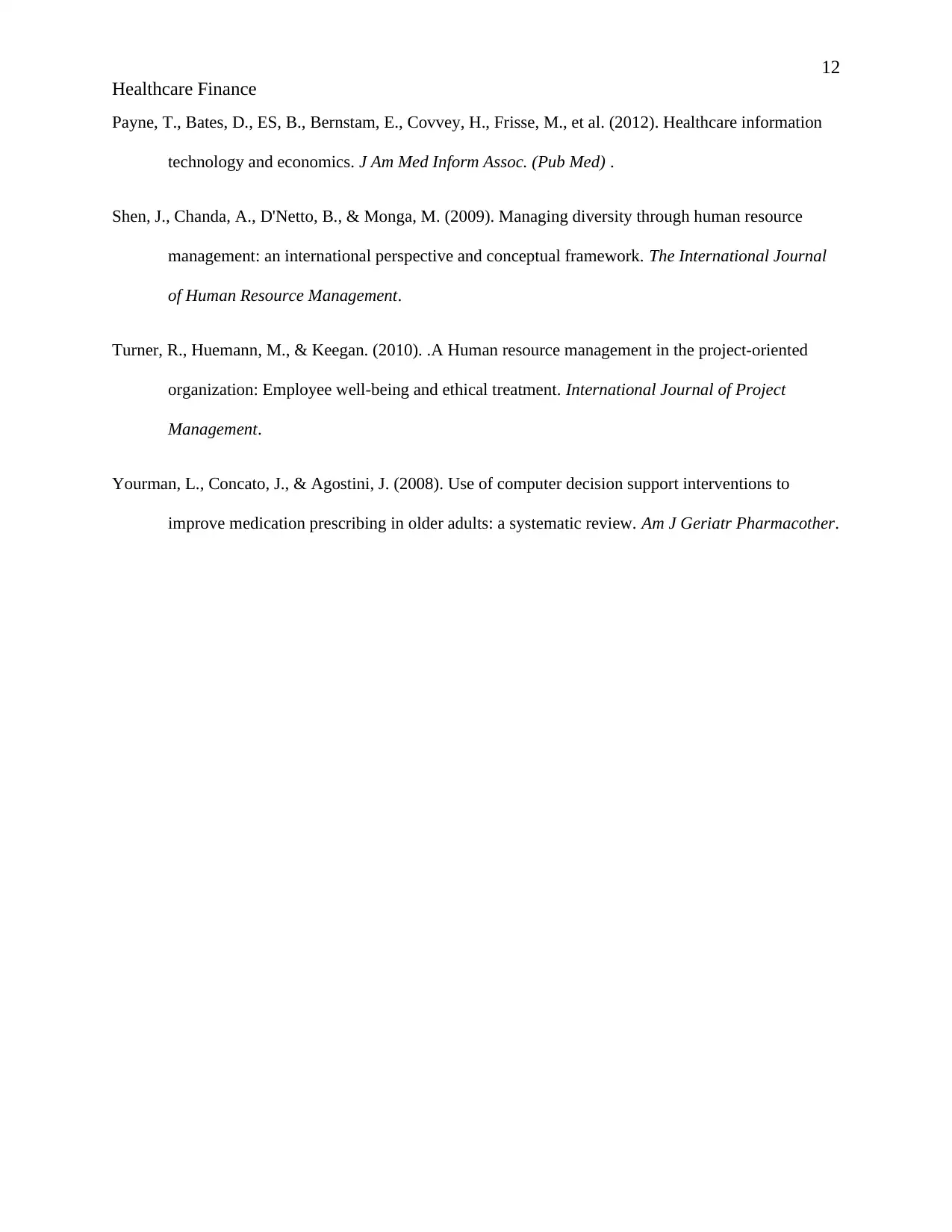
12
Healthcare Finance
Payne, T., Bates, D., ES, B., Bernstam, E., Covvey, H., Frisse, M., et al. (2012). Healthcare information
technology and economics. J Am Med Inform Assoc. (Pub Med) .
Shen, J., Chanda, A., D'Netto, B., & Monga, M. (2009). Managing diversity through human resource
management: an international perspective and conceptual framework. The International Journal
of Human Resource Management.
Turner, R., Huemann, M., & Keegan. (2010). .A Human resource management in the project-oriented
organization: Employee well-being and ethical treatment. International Journal of Project
Management.
Yourman, L., Concato, J., & Agostini, J. (2008). Use of computer decision support interventions to
improve medication prescribing in older adults: a systematic review. Am J Geriatr Pharmacother.
Healthcare Finance
Payne, T., Bates, D., ES, B., Bernstam, E., Covvey, H., Frisse, M., et al. (2012). Healthcare information
technology and economics. J Am Med Inform Assoc. (Pub Med) .
Shen, J., Chanda, A., D'Netto, B., & Monga, M. (2009). Managing diversity through human resource
management: an international perspective and conceptual framework. The International Journal
of Human Resource Management.
Turner, R., Huemann, M., & Keegan. (2010). .A Human resource management in the project-oriented
organization: Employee well-being and ethical treatment. International Journal of Project
Management.
Yourman, L., Concato, J., & Agostini, J. (2008). Use of computer decision support interventions to
improve medication prescribing in older adults: a systematic review. Am J Geriatr Pharmacother.
⊘ This is a preview!⊘
Do you want full access?
Subscribe today to unlock all pages.

Trusted by 1+ million students worldwide
1 out of 12
Related Documents
Your All-in-One AI-Powered Toolkit for Academic Success.
+13062052269
info@desklib.com
Available 24*7 on WhatsApp / Email
![[object Object]](/_next/static/media/star-bottom.7253800d.svg)
Unlock your academic potential
Copyright © 2020–2025 A2Z Services. All Rights Reserved. Developed and managed by ZUCOL.





